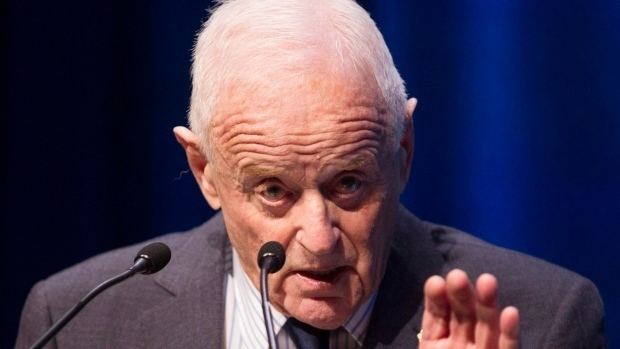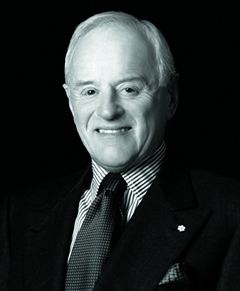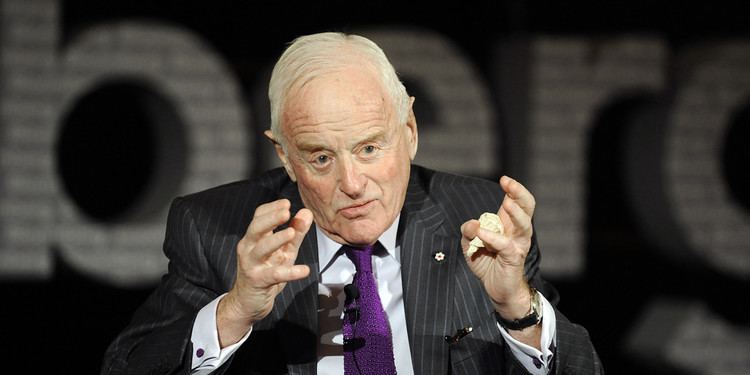Name Peter Munk Nationality Canadian Role Businessman | Ethnicity Jewish Occupation CEO of Barrick Gold | |
 | ||
Known for co-chairman and founder of Barrick Gold Spouse(s) Linda Joy Gutterson (1956-1970; divorced; 3 children)Melanie Jane Bosanquet (1973-present; 2 children) Similar People John L Thornton, Nina Munk, Nathaniel Philip Rothschild, Gustavo Cisneros, Rudyard Griffiths | ||
Peter munk full interview
Peter Munk, CC (born November 8, 1927) is a Canadian businessman and philanthropist. He is the chairman and founder of the mining company Barrick Gold, the world's largest gold-mining corporation.
Contents
- Peter munk full interview
- Oral histories peter munk
- Early years
- Clairtone
- Hospitality and Real Estate
- Barrick Gold
- Others
- Charitable contributions
- Personal life
- Honours
- References

Oral histories peter munk
Early years

Munk was born in Budapest, into a well-off Hungarian Jewish family, the son of Katharina (Adler) and Louis Munk. Hungary was invaded by Nazi Germany in March 1944 when Munk was a teenager, but along with 14 members of the Munk family, he escaped on the Kastner train. This train, which carried 1,684 Jews to safety in Switzerland, was arranged by Rudolf Kastner of the Zionist Aid and Rescue Committee as a result of secret negotiations with Adolf Eichmann. The high-ranking Nazi allowed some Jews to leave in exchange for money, gold, and diamonds, part of a series of so-called "blood for goods" deals. Munk's mother did not escape the Nazis: in July 1944, she was deported from Budapest to Auschwitz.

Munk came to Canada from Switzerland in 1948, initially on a student visa, and graduated from the University of Toronto with a degree in electrical engineering in 1952.

“I arrived in this place [Canada] not speaking the language, not knowing a dog... This is a country that does not ask about your origins, it only concerns itself with your destiny.” Peter Munk
Clairtone
In 1958, with $3,000 from his father-in-law, he founded Clairtone with business partner David Gilmour, an importer of Scandinavian furniture. Clairtone manufactured high-end console stereos and later televisions, which were recognizable icons of their day. The most celebrated Clairtone designs were the striking "Project G" series, introduced in 1964, composed of sleek rosewood cabinets with cantilevered black aluminum "sound globes" (speakers). The Project G and G2 were seen in the films "Marriage on the Rocks" and The Graduate, awarded a silver medal for excellence in design at the Milan Triennale, and endorsed by Frank Sinatra and Oscar Peterson. The firm's fans included Hugh Hefner.
Clairtone's downfall began with "an ill-advised plan to build a plant in Nova Scotia." The plant, built in Stellarton, Nova Scotia, opened in 1966 with funding from Nova Scotia’s Industrial Estates Limited (IEL). "Munk was too good a salesman for his own good. He could sell anything to anyone, including himself. My, he was a promotor. My, he had energy. My, he had charm. My, he had imagination," said William Mingo, chief counsel for IEL. In 1967, as a result of mounting losses and in order to try and recoup its multi-million dollar investments, the Government of Nova Scotia took over Clairtone and fired Munk and Gilmour. Munk was eventually the target of accusations of insider trading "that were eventually settled out of court." In 1967 a report commissioned by Clairtone in the aftermath of the factory's failure found that one of the main issues was the local workforce. "The general population is basically not geared to the manufacturing frenzy and especially the five-day workweek... The welfare situation is such that it has created conditions similar to Appalachia in the United States where the third generation is already on relief."
Hospitality and Real Estate
After the collapse of Clairtone, Munk and Gilmour invested in a plot of ocean-front land in Fiji which they soon developed into a major hotel and resort. The initial resort in Fiji would grow to become the Southern Pacific Hotel Corporation, which at its peak consisted of 54 resorts in the Australia and the South Pacific. Noted Saudi arms dealer Adnan Khashoggi was an early investor in the hotel chain, which went public on the Hong Kong stock exchange.
In 1978, the firm signed a deal with President Anwar Sadat to build a resort near the great pyramids of Egypt. When the project was cancelled by Sadat, Munk sued the Egyptian government, eventually winning the arbitration case at the [International Criminal Court]] in the Hague.
In 1979 Munk returned to Canada to start a new venture called Barrick. Upon his return he was treated poorly by bankers and the establishment. “They treated me like a fugitive and a loser,” Munk said.
Munk was founder, chairman and CEO of Trizec Properties, one of the largest U.S. REITs – listed on the NYSE, previously known as TrizecHahn Corporation. In 2006, Trizec Properties was sold to Brookfield Properties.
In 2007, Peter Munk invested with partners in Porto Montenegro, and turned it slowly into one of the world largest superyacht marina and resort complex that he built as a Mediterranean rival to Cannes or Monte Carlo. The marina, a shipyard, a five star hotel, Regent Porto Montenegro, and luxury condos are located on a former Serbian naval base on the Bay of Kotor, on the Adriatic Sea. ICD, Dubai’s sovereign wealth fund, would have bought the whole site for an undisclosed amount.
Barrick Gold
In 1980, Munk created Barrick Petroleum to invest in the oil sector, but he quickly realized that investments in this sector were ruinous. After the acquisition of a small company, Camflo Mines, Barrick left the oil sector and became overnight a mining company. American Barrick became after many transformations and acquisitions Barrick Gold. Munk recruited the best mining team he could find, motivated them, and let them run the day-to-day operations. He acquired a perfect mastery of not only M&A but also future financial instruments that enabled him to hedge Barrick's production. He managed to gradually buy back all the competitors who had not taken the same precautions. In 1986, Munk bought Goldstrike (Nevada) for USD 62 million, a small mine, already in operation for twenty years, with seemingly limited prospects. This one mine only, yielded this amount to Barrick in two weeks. Barrick's financial strength allowed it to invest in multi billion projects, such as Pueblo Viejo, in Dominican Republic (USD 3 billion project).
In 2011, Peter Munk planned to merge with Glencore, Ivan Glasenberg's company, to create one of the world's largest commodities giants at par with BHP Billiton and Rio Tinto. But the gold market was not exactly aligned with Glencore's other activities and the deal did not go through.
By the end of 2016, Barrick had proven and probable reserves of 2 billion tons (1.33 grams of gold per tonne of ore). Peter Munk is now retired from the day-to-day management but he remains the founder and President Emeritus of Barrick Gold Corporation. Barrick became the world's largest gold company and the largest Canadian company by capitalization. “Barrick is my legacy,” he says.
Others
Munk was a distinguished lecturer at James Gillies Alumni Lecture, York University, Toronto. He has also been a member of various boards including:
Charitable contributions
In 1992, the Peter and Melanie Munk Charitable Foundation was founded and has since disbursed approximately $300 million to a variety of organizations that work to improve the health, learning and international reputation of Canadians. The Munk School of Global Affairs, an interdisciplinary academic centre at the University of Toronto, carries his name and was funded with, to date, $42 million from his foundation. Likewise, the Peter Munk Cardiac Centre at the Toronto General Hospital was underwritten with $66 million from Munk.
On May 30, 2006, Munk announced that he would donate $37 million to Toronto General Hospital, at the time the largest gift ever made to a Canadian medical institution. The donation would help to support the Peter Munk Cardiac Centre, which Munk helped create with an earlier $6 million donation in 1997. He is also a major donor to the University of Toronto, to which he has donated $50.9 million to establish the Munk School of Global Affairs. Peter and Melanie Munk also established UHN’s first endowed chair for the cardiac program: the Melanie Munk Chair in Cardiovascular Surgery. The foundation also created the Munk Debates. The latest contract between the Munk Foundation and the University of Toronto has come under criticism due to the secrecy that shrouded its approval, and the fact that Munk's contribution of $35 million were conditional on $25 million contributions each by the federal government and the university. Coming at a time of downsizing and threats to the funding of other academic units, critics charge that these decisions are emblematic of the government's and the University's ceding of academic resource allocation decisions to the corporate sector.
According to Linda McQuaig's book, The Trouble with Billionaires, Munk’s latest donation to the University of Toronto came with strings attached to ensure that the school would "fit with the political views and sensitivities of Peter Munk." McQuaig writes that "according to Munk's written agreement with the university, the Munk donations will be paid over an extended time period, with much of the money to be paid years from now — and subject to the Munk family's approval of the school. For that matter, the school's director will be required to report annually to a board appointed by Munk 'to discuss the programs, activities and initiatives of the School in greater detail.'"
University president David Naylor rejected personal attacks on donors as "a deplorable affront to the values of rational and respectful discourse that are supposed to characterize a university" and stated "I later served on the board of the University Health Network, in the years when Dr. Munk made two gifts exceeding $40 million to support the cardiovascular program at that hospital. There was not a single instance where Peter Munk interfered with the educational, research or clinical priorities of the institution."
In 2016, Munk made a $5 million donation to the Fraser Institute, a Canadian think tank, to launch the Peter Munk Centre for Free Enterprise Education.
On September 19, 2017 the Peter and Melanie Munk Charitable foundation announced the largest gift to a Canadian hospital, with an additional pledge of $100 million to the Peter Munk Cardiac Center (PMCC), bringing the total to $175 million. This historic gift will enable the PMCC to continue to lead the future of cardiac care globally and change the way cardiovascular patients are treated in Ontario, Canada and around the world.
Personal life
In 1956, Munk married Linda Joy (Gutterson), the daughter of a Forest Hill pharmaceutical entrepreneur who gave him the start-up capital to fund his first company. Linda was 19, not long out of Havergal College; he was 10 years older. “Linda tracked me down with a laser beam,” said Mr. Munk. “I was a curiosity; I was different. Not because I was so great, let me tell you, I was fat, bald, poor, a boring engineering student.” The couple separated and reunited more than once in the 1960s, having three children and divorcing in 1970 but staying on very good terms. After the marriage was over, she pursued an academic career, becoming a professor of English at the University of Toronto.
In 1973, Munk married his current wife, Melanie Jane Bosanquet, with whom he had two more children. She is the cousin of Charles Palmer-Tomkinson, a British land-owner and Olympic skier. Peter Munk skied for 71 years, and built with his wife in 1972 a ski chalet called Viti Levu in Klosters, where they spend their winters.
His children are Anthony, a director of Onex Corporation and his father's company Barrick Gold; Nina Munk, a New York-based journalist, book author, and contributing editor at Vanity Fair; Marc-David, a physician; Natalie; and Cheyne, formerly principal of her sister Nina's UrbanHound.com site.
Honours
He has received several honorary degrees:
He became Officer of The Order of Canada (Canada's highest civilian honour) in 1993 and was promoted to Companion in 2008; received The Woodrow Wilson Award for Corporate Citizenship in 2002 (the first time awarded outside the U.S.); has been inducted into the Canadian Business Hall of Fame, and the Canadian Mining Hall of Fame.
